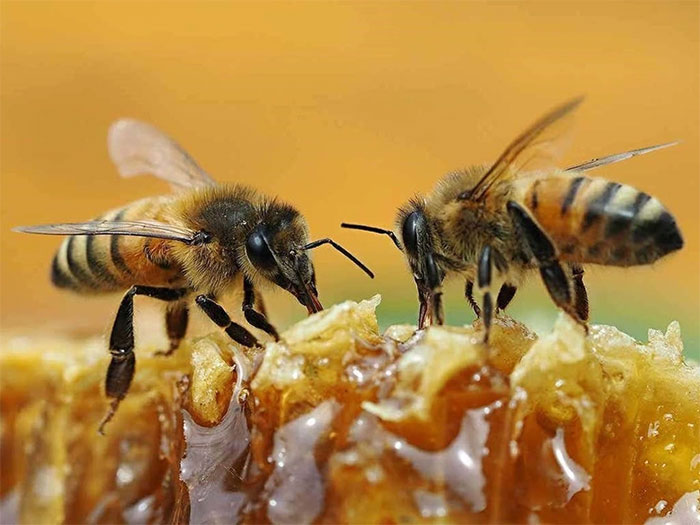Surprised with the ability to know even and odd numbers of honey bees
A published study shows that honey bees can learn to calculate even and odd numbers just like humans.
The learning and cognitive abilities of animals are still a mystery to scientists.
As children, we learned to distinguish between even and odd numbers. Accordingly, the rule that numbers ending in 1, 3, 5, 7 or 9 are odd while numbers ending in 0, 2, 4, 6 or 8 are even has become a. pretty thing. apparent.
To date, the classification between even and odd, also known as the parity classification, has never been recorded in non-human animals. But in a study published in the journal Frontiers in Ecology and Evolution, scientists in Australia discovered this unique ability in honey bees for the first time.
How do scientists teach bees to count?

Bees trained through associating odd numbers with sugar water learn faster.
In the past, several studies have shown that honey bees can learn to sort numbers, perform simple addition and subtraction, and associate symbols with quantities.
To teach bees to count even and odd numbers, the researchers split individuals into two groups: One group was trained to associate even numbers with sugar water, and the other group was trained to associate odd numbers with flavored liquids. bitter. Then they do the opposite.
In the final round, they trained each bee by comparing odd to even numbers with cards printed with numbers 1-10, until they chose the correct answer with 80% accuracy. .
In particular, bees trained through the association of odd numbers with sugar water will learn faster. This is said to be in contrast to humans, as we tend to classify even numbers better.
Why even and odd?
The task of distinguishing even - odd has long been considered a high-level and abstract arithmetic concept, unique to humans. The interesting thing is that humans can make connections in many areas such as accuracy, speed, language and bias. when sorting odd or even numbers.
For example, we tend to respond more quickly to even numbers by relating them to actions performed by the right hand. Similar are odd numbers with actions performed by the left hand.
Studies suggest that humans may have learned innate biases about even and odd numbers, which may have arisen through centuries of evolution.
Therefore, understanding how and how other animals perceive even and odd numbers can help us learn more about the history of humanity itself.
In addition, the results of the study also help us understand more about how mathematics and abstract thinking form in humans, through the small brain, consisting of only 960,000 neurons, in bees. secret, but can still understand the concepts of even and odd numbers and distinguish them no less than a human (with 86 billion neurons), if they are properly trained.
- Find out the 'secret' to make honey bees into queen bees
- Honey bees originated in Asia
- 'Biological mystery' in South African honey bees
- Honey bees can enjoy pictures
- Ability to neutralize toxic insecticides of honey bees
- The secret of bees
- Honey bees forget their way to the nest because of pesticides
- Not only humans, bees are also stressed out for work
- Investigate the death of 20,000 bees
- Crazy honey creates excitement like marijuana
- The world's first vaccine for honey bees
- How do honeybee clusters overcome the wind blows?
 Why do potatoes have eyes?
Why do potatoes have eyes? 'Tragedy' the world's largest carnivorous life: Death becomes ... public toilet
'Tragedy' the world's largest carnivorous life: Death becomes ... public toilet Tomatoes were once considered 'poisonous' for 200 years
Tomatoes were once considered 'poisonous' for 200 years Detecting microscopic parasites on human face
Detecting microscopic parasites on human face Nikola Tesla and obsession 3, 6, 9
Nikola Tesla and obsession 3, 6, 9  New technology 'technology' teaches math in the world: Discover algebraic rules before counting 1, 2, 3, 4 ... (Part 4)
New technology 'technology' teaches math in the world: Discover algebraic rules before counting 1, 2, 3, 4 ... (Part 4)  New technology 'technology' teaches math in the world: Discover algebraic rules before counting 1, 2, 3, 4 ... (Part 2)
New technology 'technology' teaches math in the world: Discover algebraic rules before counting 1, 2, 3, 4 ... (Part 2)  How was mathematics invented?
How was mathematics invented?  Why are China, Japan and Korea reading numbers according to the Chinese system, only Vietnam is different?
Why are China, Japan and Korea reading numbers according to the Chinese system, only Vietnam is different?  Accidentally saw the moment 11:11 minutes, what does it mean?
Accidentally saw the moment 11:11 minutes, what does it mean? 